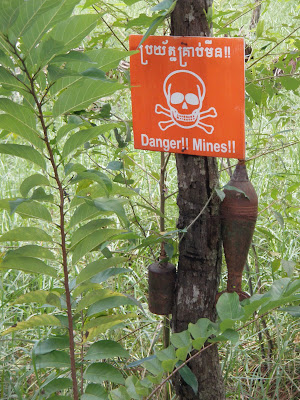 -A stunning view of Angkor Wat just before a shower.-
-A stunning view of Angkor Wat just before a shower.-We were excited for our visit to Angkor Wat (literally meaning, City Temple). It had always been one of those places that we'd dreamed of visiting but never actually thought that we'd see. Over our three day visit in the temple region we managed to visit Angkor Wat (the most famous temple of a vast number of temples all within the Angkor vicinity) three times. We caught glimpses of it early in the morning (5 am, well before the sun got up), during the day (through sunshine and showers) and late into the evening (when the towers were magnificently lit). We loved strolling around the massive gardens of this great wonder, admiring it's amazing bas-relief carvings and marveling at the sheer task force it must have taken to construct such a city.
 -An evening shot down one of the many temple corridors.-
-An evening shot down one of the many temple corridors.- -Sunrise at Angkor Wat.-
-Sunrise at Angkor Wat.-A Brief Bit of Background Information
Angkor Wat was built mostly from limestone and was constructed in the 12
th century during the reign of Khmer King,
Suryavarman II (ruling from 1113AD until 1150AD). Its purpose was to be the state temple and the capital city of his kingdom. Angkor Wat is surrounded by a huge moat (190 metres across) which encloses the grounds of 820,000 square metres (203 acres) and the entire city/temple, inclusive of: an outer and an inner city wall, temples, libraries, ponds, not to mention a terrace, a causeway and a forests. To us it was no wonder that this site is sometimes considered the eighth wonder of the world.
 -Silhouette of a temple archway.-
-Silhouette of a temple archway.- -Intricate engravings along a long passageway.-
-Intricate engravings along a long passageway.-"Is of such extraordinary construction that it is not possible to describe it with a pen, particularly since it is like no other building in the world. It has towers and decoration and all the refinements which the human genius can conceive of". (
Portuguese monk upon visiting in 1586)
 -Ancient stairs leading up to the center of Angkor Wat.-
-Ancient stairs leading up to the center of Angkor Wat.- -A rainbow after a short evening shower.-
-A rainbow after a short evening shower.-History of Temple Use
12th century
Built as a Hindu temple by the Khmer King
Suryavarman II. Later attacked by the
Chams from what is now known as Vietnam.
14th-15th centuriesConverted into a Buddhist temple. The Buddhist affiliation remains to this day.
16th century Received its first visitors from abroad.
20th century Restoration work began on the temple to free it of the encroaching jungle and debris. Work on the temple was put to an end during the Cambodian civil war (1970's - 1980's). During this time theft was almost the only damage to speak of.
 -Early morning reflections.-
-Early morning reflections.- -6 am-
-6 am- -Waiting out the rain.-
-Waiting out the rain.-For more information:
Angkor Wat




















































